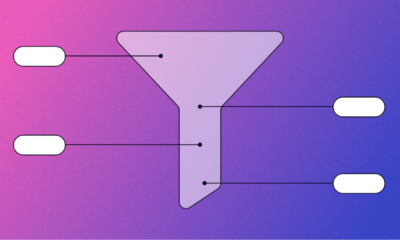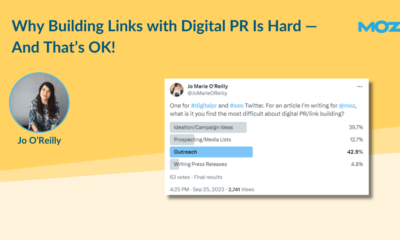MARKETING
8 Factors to Consider Before Buying or Building your AI Solution
Artificial intelligence (AI) – it’s here, it’s there, it’s everywhere. Businesses in every vertical – retail, finance, healthcare, manufacturing, transport, supply chain, entertainment, and technology – use AI.
More than a quarter of companies using AI attribute at least 5% of their earnings before interest and taxes to AI. Almost two-thirds of early AI adopters note AI gives them a competitive advantage. Given the benefits, it’s hardly surprising that some businesses have FOMO on AI.
But when the company is ready to adopt AI, they face a dilemma – should they buy or build? Read on to learn about factors to consider when deciding on AI solutions for your business.
AI for business
Startups and big enterprises ready to adopt AI have two ways to go about it: Build their own AI model or buy commercially available AI software. Both options involve the use of open-source AI or off-the-shelf product such as free live chat apps
Before dissecting the build vs buy dilemma, it’s important to understand open-source and proprietary AI software.
Open-source AI
Open-source AI includes freely available AI tools. These could be algorithms, datasets, ready-to-use application programming interfaces (APIs), libraries of codes, or a combination of all. Some of the free AI and machine learning (ML) platforms are Tensorflow, Python, PyTorch, KNIME, Apache Spark, and H2O.ai.
Usually, each AI software has specific use cases like speech recognition, computer vision, ML, natural language processing (NLP), or big data analytics. For instance, TensorFlow and PyTorch are suited for building ML and deep learning models. Libraries like Keras and OpenNN, on the other hand, are artificial neural network (ANN) frameworks. Businesses leverage these libraries and platforms to build their own AI system based on their requirements.
Commercial AI software
From chatbots and conversational AI to automation and advanced data science, there are many ready-to-use AI tools. Though it’s costly, these tools can save a lot of resources and time for the company. The most common commercial model of AI software is the annual subscription model that includes necessary licenses, support, and service from vendors. Another type is “pay-as-you-go” where one can access the AI software as an API.
Major tech companies like Google, Microsoft, Amazon, IBM, and Salesforce also offer AI and ML as a platform service. These AI services provide end-to-end cloud-hosted platforms for developing and deploying AI models.
Breaking down the build vs buy dilemma
Imagine you need a new house – would you buy or build one? Choosing between the two depends on a lot of factors. What kind of house do you want? What resources do you have on hand? How much time and money do you have? And how much of each are you willing to spend?
Deciding on whether you want to build or buy your AI for your business is similar. Let’s look at the factors you should consider before taking the plunge.
The need: Why do you need AI?
Diving into algorithms and neural networks before figuring out what you want from AI is a bit like diving into the ocean to find a lost treasure that might or might not exist. What is your business looking to achieve by using AI tools? Is AI a core component of future business growth? Or is it to automate a task or improve business processes?
If AI is the core of your business, build it. If you want to use AI for just specific business operations, then buy. A chatbot provider needs to build its own NLP model. But a small online startup doesn’t have to build a huge NLP model to have a chatbot on its website. It can simply buy the tool from conversational AI providers like Dialpad or Drift and improve customer experience.
The difficulty: How complex is the AI solution?
The complexity of the AI solution the business is looking to adopt is also an important element to think about. There are many tried and tested products in the market that you can buy for common AI applications, like sales and marketing automation processes, predictive forecasting, chatbots, speech-to-text, or machine translation.
But sometimes, the data involved is sensitive or the business is looking for a novel solution. Commercial tools are simply not suitable or sufficient in these cases. Netflix, for instance, built its own proprietary AI model that offers personalized movies and shows recommendations based on user data. It was worth it to build because Netflix considers this feature critical to its business.
On the other hand, Woodside Energy, an oil and gas company, leveraged IBM Watson’s ML and NLP tech to make 30 years of data on oil platform operations accessible throughout the company. Woodside owns the data, but shared it with IBM to tap their expertise instead of building it in-house.
The human effort: Do you have the right people?
Evaluate the AI capabilities of your in-house experts. Can your pool of technical experts develop AI frameworks? Or does your firm have the resources to hire such experts? If yes, then the firm can think about building an AI model in-house.
Tech companies, AI vendors, and large enterprises in the banking, retail, and healthcare sectors have a huge pool of AI experts working exclusively on AI and have the resources to develop their solutions in-house.
Bank of America, for example, built its own virtual banking assistant, Erica. By the time the bank’s AI assistant was in the beta phase in 2017, the bank had a dedicated team of more than 100 people working on the project.
However, if the firm doesn’t have technical expertise or resources to hire, it’s best to purchase from a vendor. For example, a small marketing firm can buy an AI-powered content creation tool rather than investing millions to hire a team and develop it in-house.
The time: What’s the deadline?
Do you need the AI software immediately? Or can you wait to get a custom tool?
If your business needs the tool at once, and there are already multiple products available to purchase, then buying is the ideal solution. But, if the company needs a custom tool that needs time to build, the firm can develop on its own, given it has the resources to do it.
The cost: What’s the budget?
Many enterprises fail to understand the true cost of building or buying an AI model. Both options require heavy investment to get the right people, hardware, and software.
A company can cut some costs by building AI using free, open-source software. But there are other prices to pay. From getting training data to buying necessary software and hardware like cloud storage, expensive computing power, and AI operationalization software, there are significant hidden costs involved. Companies have to cough up more to hire (expensive and rare) AI experts. The average base pay for an AI job is easily above $100,000 in the USA.
Buying a third-party AI solution solves the problem of having to spend on hiring an AI team. But commercial tools can still be expensive. A custom AI solution can cost from $6000 to over $300,000 per solution while a third-party software can cost up to $40,000 per year. Firms will have to weigh the costs of both options and decide.
The integration: Can your current tech support AI?
It’s critical to gauge how well the existing IT infrastructure can integrate with AI, whether building or buying. The team should look at whether the AI platform can sync with their current tech stack. More often than not, open-source platforms have integration and scaling issues.
Commercial vendors take care of the dreaded task of AI integration, scaling, and compatibility issues. But it’s always better to check the compatibility of the vendor tool with the existing ecosystem. If you’re integrating an AI solution to optimize your lead generation process, it should seamlessly integrate with your existing CRM. Ignoring this can become costly to fix.
The service: What happens when something goes wrong??
With commercial products, there’s always vendor service and support. The AI vendor has responsibility and accountability for the smooth functioning of the tool. Your team can rely on them to fix bugs and other issues that crop up in the AI model. While building AI, the company has to deal with any issues that crop up without much support.
The security: Is your AI safe?
Both open-source and commercial AI platforms have potential security risks. Unlike popular opinion that open source has more vulnerabilities, nearly 90% of IT leaders think it’s as secure or more secure than proprietary software. So the question is not about which option is more secure but which needs more support. The answer is building with open source. AI vendors take care of security issues and fix bugs and patches themselves. But building AI in-house means having a team dedicated to looking at potential security issues. This adds significant costs to the budget.
Building vs buying AI: Weighing the pros and cons
Let‘s make your decision-making on AI solutions a little easier. Here are some common advantages and disadvantages of building vs buying AI.
Pros and cons of building AI
Building an in-house AI using open-source frameworks suits firms that have unique data and the capability to invest time and resources. Its advantages include:
- no or low-cost investment in the tech
- better customization based on needs
- control over both data and the model
- flexibility to change the model when required
- community support
However, open-source AI platforms have several gaps like:
- high turnaround time
- difficulty in hiring AI experts and data scientists
- lack of service and support to solve issues
- added security cost
- compatibility issues with other software
Pros and cons of buying proprietary AI
Buying an off-the-shelf commercial tool might be best for companies that don’t have the human resources to build their own solution or lack unique datasets. Its advantages include:
- specialized knowledge for a particular AI use case
- availability of large, well-organized training datasets
- seamless integration of AI tools into existing infrastructure
- ability to scale AI models
- continuous vendor service and support to solve issues
But commercial products have their own drawbacks like:
- high investment cost
- fewer customization options
- risk of losing access to critical data
- vendor lock-in periods
Still confused? Go for the lean strategy
If you’re still confused after assessing all factors, think about the lean AI strategy. The strategy comes from the Japanese manufacturing industries’ philosophy called the lean manufacturing process. Adopted by carmakers like Toyota, the strategy aims to reduce production waste without sacrificing efficiency and quality.
The lean AI strategy also aims for the same: implement AI incrementally while reducing resource costs and risks. The business can start with a small AI project that delivers a minimum viable AI product (MVAP).
The build-vs-buy decision tree
With MVAP in mind, consider the following decision tree. Scout for an available solution. If there are multiple commercial products, buying would be the best solution. If there are not many vendors offering the required tool, look for a partner to develop a custom AI solution. This saves the company time, efforts, and resources of building from scratch.
However, if both buying and partnering don’t work, the company can build its MVAP. Aiming at MVAP helps the company kickstart the AI project sooner. With established deadlines and goals, companies can assess the performance and business impact of MVAP faster. As the project matures, the business gets more opportunities to evaluate and undertake more ambitious AI projects.
Winning with AI
Like all deliberations about implementing new technologies, it’s important to make an informed decision on AI in your company. Whether you choose to build or buy your AI, just keep in mind that AI is not going anywhere anytime soon – so start early to reap the rewards early.
MARKETING
Ecommerce evolution: Blurring the lines between B2B and B2C

Understanding convergence
B2B and B2C ecommerce are two distinct models of online selling. B2B ecommerce is between businesses, such as wholesalers, distributors, and manufacturers. B2C ecommerce refers to transactions between businesses like retailers and consumer brands, directly to individual shoppers.
However, in recent years, the boundaries between these two models have started to fade. This is known as the convergence between B2B and B2C ecommerce and how they are becoming more similar and integrated.
Source: White Paper: The evolution of the B2B Consumer Buyer (ClientPoint, Jan 2024)
What’s driving this change?
Ever increasing customer expectations
Customers today expect the same level of convenience, speed, and personalization in their B2B transactions as they do in their B2C interactions. B2B buyers are increasingly influenced by their B2C experiences. They want research, compare, and purchase products online, seamlessly transitioning between devices and channels. They also prefer to research and purchase online, using multiple devices and channels.
Forrester, 68% of buyers prefer to research on their own, online . Customers today expect the same level of convenience, speed, and personalization in their B2B transactions as they do in their B2C interactions. B2B buyers are increasingly influenced by their B2C experiences. They want research, compare, and purchase products online, seamlessly transitioning between devices and channels. They also prefer to research and purchase online, using multiple devices and channels
Technology and omnichannel strategies
Technology enables B2B and B2C ecommerce platforms to offer more features and functionalities, such as mobile optimization, chatbots, AI, and augmented reality. Omnichannel strategies allow B2B and B2C ecommerce businesses to provide a seamless and consistent customer experience across different touchpoints, such as websites, social media, email, and physical stores.
However, with every great leap forward comes its own set of challenges. The convergence of B2B and B2C markets means increased competition. Businesses now not only have to compete with their traditional rivals, but also with new entrants and disruptors from different sectors. For example, Amazon Business, a B2B ecommerce platform, has become a major threat to many B2B ecommerce businesses, as it offers a wide range of products, low prices, and fast delivery
“Amazon Business has proven that B2B ecommerce can leverage popular B2C-like functionality” argues Joe Albrecht, CEO / Managing Partner, Xngage. . With features like Subscribe-and-Save (auto-replenishment), one-click buying, and curated assortments by job role or work location, they make it easy for B2B buyers to go to their website and never leave. Plus, with exceptional customer service and promotional incentives like Amazon Business Prime Days, they have created a reinforcing loyalty loop.
And yet, according to Barron’s, Amazon Business is only expected to capture 1.5% of the $5.7 Trillion addressable business market by 2025. If other B2B companies can truly become digital-first organizations, they can compete and win in this fragmented space, too.”
If other B2B companies can truly become digital-first organizations, they can also compete and win in this fragmented space
Joe AlbrechtCEO/Managing Partner, XNGAGE
Increasing complexity
Another challenge is the increased complexity and cost of managing a converging ecommerce business. Businesses have to deal with different customer segments, requirements, and expectations, which may require different strategies, processes, and systems. For instance, B2B ecommerce businesses may have to handle more complex transactions, such as bulk orders, contract negotiations, and invoicing, while B2C ecommerce businesses may have to handle more customer service, returns, and loyalty programs. Moreover, B2B and B2C ecommerce businesses must invest in technology and infrastructure to support their convergence efforts, which may increase their operational and maintenance costs.
How to win
Here are a few ways companies can get ahead of the game:
Adopt B2C-like features in B2B platforms
User-friendly design, easy navigation, product reviews, personalization, recommendations, and ratings can help B2B ecommerce businesses to attract and retain more customers, as well as to increase their conversion and retention rates.
According to McKinsey, ecommerce businesses that offer B2C-like features like personalization can increase their revenues by 15% and reduce their costs by 20%. You can do this through personalization of your website with tools like Product Recommendations that help suggest related products to increase sales.
Focus on personalization and customer experience
B2B and B2C ecommerce businesses need to understand their customers’ needs, preferences, and behaviors, and tailor their offerings and interactions accordingly. Personalization and customer experience can help B2B and B2C ecommerce businesses to increase customer satisfaction, loyalty, and advocacy, as well as to improve their brand reputation and competitive advantage. According to a Salesforce report, 88% of customers say that the experience a company provides is as important as its products or services.
Market based on customer insights
Data and analytics can help B2B and B2C ecommerce businesses to gain insights into their customers, markets, competitors, and performance, and to optimize their strategies and operations accordingly. Data and analytics can also help B2B and B2C ecommerce businesses to identify new opportunities, trends, and innovations, and to anticipate and respond to customer needs and expectations. According to McKinsey, data-driven organizations are 23 times more likely to acquire customers, six times more likely to retain customers, and 19 times more likely to be profitable.
What’s next?
The convergence of B2B and B2C ecommerce is not a temporary phenomenon, but a long-term trend that will continue to shape the future of ecommerce. According to Statista, the global B2B ecommerce market is expected to reach $20.9 trillion by 2027, surpassing the B2C ecommerce market, which is expected to reach $10.5 trillion by 2027. Moreover, the report predicts that the convergence of B2B and B2C ecommerce will create new business models, such as B2B2C, B2A (business to anyone), and C2B (consumer to business).
Therefore, B2B and B2C ecommerce businesses need to prepare for the converging ecommerce landscape and take advantage of the opportunities and challenges it presents. Here are some recommendations for B2B and B2C ecommerce businesses to navigate the converging landscape:
- Conduct a thorough analysis of your customers, competitors, and market, and identify the gaps and opportunities for convergence.
- Develop a clear vision and strategy for convergence, and align your goals, objectives, and metrics with it.
- Invest in technology and infrastructure that can support your convergence efforts, such as cloud, mobile, AI, and omnichannel platforms.
- Implement B2C-like features in your B2B platforms, and vice versa, to enhance your customer experience and satisfaction.
- Personalize your offerings and interactions with your customers, and provide them with relevant and valuable content and solutions.
- Leverage data and analytics to optimize your performance and decision making, and to innovate and differentiate your business.
- Collaborate and partner with other B2B and B2C ecommerce businesses, as well as with other stakeholders, such as suppliers, distributors, and customers, to create value and synergy.
- Monitor and evaluate your convergence efforts, and adapt and improve them as needed.
By following these recommendations, B2B and B2C ecommerce businesses can bridge the gap between their models and create a more integrated and seamless ecommerce experience for their customers and themselves.
MARKETING
Streamlining Processes for Increased Efficiency and Results

How can businesses succeed nowadays when technology rules? With competition getting tougher and customers changing their preferences often, it’s a challenge. But using marketing automation can help make things easier and get better results. And in the future, it’s going to be even more important for all kinds of businesses.
So, let’s discuss how businesses can leverage marketing automation to stay ahead and thrive.
Benefits of automation marketing automation to boost your efforts
First, let’s explore the benefits of marketing automation to supercharge your efforts:
Marketing automation simplifies repetitive tasks, saving time and effort.
With automated workflows, processes become more efficient, leading to better productivity. For instance, automation not only streamlines tasks like email campaigns but also optimizes website speed, ensuring a seamless user experience. A faster website not only enhances customer satisfaction but also positively impacts search engine rankings, driving more organic traffic and ultimately boosting conversions.
Automation allows for precise targeting, reaching the right audience with personalized messages.
With automated workflows, processes become more efficient, leading to better productivity. A great example of automated workflow is Pipedrive & WhatsApp Integration in which an automated welcome message pops up on their WhatsApp
within seconds once a potential customer expresses interest in your business.
Increases ROI
By optimizing campaigns and reducing manual labor, automation can significantly improve return on investment.
Leveraging automation enables businesses to scale their marketing efforts effectively, driving growth and success. Additionally, incorporating lead scoring into automated marketing processes can streamline the identification of high-potential prospects, further optimizing resource allocation and maximizing conversion rates.
Harnessing the power of marketing automation can revolutionize your marketing strategy, leading to increased efficiency, higher returns, and sustainable growth in today’s competitive market. So, why wait? Start automating your marketing efforts today and propel your business to new heights, moreover if you have just learned ways on how to create an online business
How marketing automation can simplify operations and increase efficiency
Understanding the Change
Marketing automation has evolved significantly over time, from basic email marketing campaigns to sophisticated platforms that can manage entire marketing strategies. This progress has been fueled by advances in technology, particularly artificial intelligence (AI) and machine learning, making automation smarter and more adaptable.
One of the main reasons for this shift is the vast amount of data available to marketers today. From understanding customer demographics to analyzing behavior, the sheer volume of data is staggering. Marketing automation platforms use this data to create highly personalized and targeted campaigns, allowing businesses to connect with their audience on a deeper level.
The Emergence of AI-Powered Automation
In the future, AI-powered automation will play an even bigger role in marketing strategies. AI algorithms can analyze huge amounts of data in real-time, helping marketers identify trends, predict consumer behavior, and optimize campaigns as they go. This agility and responsiveness are crucial in today’s fast-moving digital world, where opportunities come and go in the blink of an eye. For example, we’re witnessing the rise of AI-based tools from AI website builders, to AI logo generators and even more, showing that we’re competing with time and efficiency.
Combining AI-powered automation with WordPress management services streamlines marketing efforts, enabling quick adaptation to changing trends and efficient management of online presence.
Moreover, AI can take care of routine tasks like content creation, scheduling, and testing, giving marketers more time to focus on strategic activities. By automating these repetitive tasks, businesses can work more efficiently, leading to better outcomes. AI can create social media ads tailored to specific demographics and preferences, ensuring that the content resonates with the target audience. With the help of an AI ad maker tool, businesses can efficiently produce high-quality advertisements that drive engagement and conversions across various social media platforms.
Personalization on a Large Scale
Personalization has always been important in marketing, and automation is making it possible on a larger scale. By using AI and machine learning, marketers can create tailored experiences for each customer based on their preferences, behaviors, and past interactions with the brand.
This level of personalization not only boosts customer satisfaction but also increases engagement and loyalty. When consumers feel understood and valued, they are more likely to become loyal customers and brand advocates. As automation technology continues to evolve, we can expect personalization to become even more advanced, enabling businesses to forge deeper connections with their audience. As your company has tiny homes for sale California, personalized experiences will ensure each customer finds their perfect fit, fostering lasting connections.
Integration Across Channels
Another trend shaping the future of marketing automation is the integration of multiple channels into a cohesive strategy. Today’s consumers interact with brands across various touchpoints, from social media and email to websites and mobile apps. Marketing automation platforms that can seamlessly integrate these channels and deliver consistent messaging will have a competitive edge. When creating a comparison website it’s important to ensure that the platform effectively aggregates data from diverse sources and presents it in a user-friendly manner, empowering consumers to make informed decisions.
Omni-channel integration not only betters the customer experience but also provides marketers with a comprehensive view of the customer journey. By tracking interactions across channels, businesses can gain valuable insights into how consumers engage with their brand, allowing them to refine their marketing strategies for maximum impact. Lastly, integrating SEO services into omni-channel strategies boosts visibility and helps businesses better understand and engage with their customers across different platforms.
The Human Element
While automation offers many benefits, it’s crucial not to overlook the human aspect of marketing. Despite advances in AI and machine learning, there are still elements of marketing that require human creativity, empathy, and strategic thinking.
Successful marketing automation strikes a balance between technology and human expertise. By using automation to handle routine tasks and data analysis, marketers can focus on what they do best – storytelling, building relationships, and driving innovation.
Conclusion
The future of marketing automation looks promising, offering improved efficiency and results for businesses of all sizes.
As AI continues to advance and consumer expectations change, automation will play an increasingly vital role in keeping businesses competitive.
By embracing automation technologies, marketers can simplify processes, deliver more personalized experiences, and ultimately, achieve their business goals more effectively than ever before.
MARKETING
Will Google Buy HubSpot? | Content Marketing Institute

Google + HubSpot. Is it a thing?
This week, a flurry of news came down about Google’s consideration of purchasing HubSpot.
The prospect dismayed some. It delighted others.
But is it likely? Is it even possible? What would it mean for marketers? What does the consideration even mean for marketers?
Well, we asked CMI’s chief strategy advisor, Robert Rose, for his take. Watch this video or read on:
Why Alphabet may want HubSpot
Alphabet, the parent company of Google, apparently is contemplating the acquisition of inbound marketing giant HubSpot.
The potential price could be in the range of $30 billion to $40 billion. That would make Alphabet’s largest acquisition by far. The current deal holding that title happened in 2011 when it acquired Motorola Mobility for more than $12 billion. It later sold it to Lenovo for less than $3 billion.
If the HubSpot deal happens, it would not be in character with what the classic evil villain has been doing for the past 20 years.
At first glance, you might think the deal would make no sense. Why would Google want to spend three times as much as it’s ever spent to get into the inbound marketing — the CRM and marketing automation business?
At a second glance, it makes a ton of sense.
I don’t know if you’ve noticed, but I and others at CMI spend a lot of time discussing privacy, owned media, and the deprecation of the third-party cookie. I just talked about it two weeks ago. It’s really happening.
All that oxygen being sucked out of the ad tech space presents a compelling case that Alphabet should diversify from third-party data and classic surveillance-based marketing.
Yes, this potential acquisition is about data. HubSpot would give Alphabet the keys to the kingdom of 205,000 business customers — and their customers’ data that almost certainly numbers in the tens of millions. Alphabet would also gain access to the content, marketing, and sales information those customers consumed.
Conversely, the deal would provide an immediate tip of the spear for HubSpot clients to create more targeted programs in the Alphabet ecosystem and upload their data to drive even more personalized experiences on their own properties and connect them to the Google Workspace infrastructure.
When you add in the idea of Gemini, you can start to see how Google might monetize its generative AI tool beyond figuring out how to use it on ads on search results pages.
What acquisition could mean for HubSpot customers
I may be stretching here but imagine this world. As a Hubspoogle customer, you can access an interface that prioritizes your owned media data (e.g., your website, your e-commerce catalog, blog) when Google’s Gemini answers a question).
Recent reports also say Google may put up a paywall around the new premium features of its artificial intelligence-powered Search Generative Experience. Imagine this as the new gating for marketing. In other words, users can subscribe to Google’s AI for free, but Hubspoogle customers can access that data and use it to create targeted offers.
The acquisition of HubSpot would immediately make Google Workspace a more robust competitor to Microsoft 365 Office for small- and medium-sized businesses as they would receive the ADDED capability of inbound marketing.
But in the world of rented land where Google is the landlord, the government will take notice of the acquisition. But — and it’s a big but, I cannot lie (yes, I just did that). The big but is whether this acquisition dance can happen without going afoul of regulatory issues.
Some analysts say it should be no problem. Others say, “Yeah, it wouldn’t go.” Either way, would anybody touch it in an election year? That’s a whole other story.
What marketers should realize
So, what’s my takeaway?
It’s a remote chance that Google will jump on this hard, but stranger things have happened. It would be an exciting disruption in the market.
The sure bet is this. The acquisition conversation — as if you needed more data points — says getting good at owned media to attract and build audiences and using that first-party data to provide better communication and collaboration with your customers are a must.
It’s just a matter of time until Google makes a move. They might just be testing the waters now, but they will move here. But no matter what they do, if you have your customer data house in order, you’ll be primed for success.
HANDPICKED RELATED CONTENT:
Cover image by Joseph Kalinowski/Content Marketing Institute
-

 MARKETING7 days ago
MARKETING7 days agoRoundel Media Studio: What to Expect From Target’s New Self-Service Platform
-

 SEO6 days ago
SEO6 days agoGoogle Limits News Links In California Over Proposed ‘Link Tax’ Law
-
SEARCHENGINES6 days ago
Daily Search Forum Recap: April 12, 2024
-

 SEO5 days ago
SEO5 days ago10 Paid Search & PPC Planning Best Practices
-

 SEARCHENGINES5 days ago
SEARCHENGINES5 days agoGoogle Core Update Volatility, Helpful Content Update Gone, Dangerous Google Search Results & Google Ads Confusion
-

 MARKETING6 days ago
MARKETING6 days ago2 Ways to Take Back the Power in Your Business: Part 2
-

 MARKETING4 days ago
MARKETING4 days ago5 Psychological Tactics to Write Better Emails
-

 SEARCHENGINES4 days ago
SEARCHENGINES4 days agoWeekend Google Core Ranking Volatility















You must be logged in to post a comment Login